How To Build A Website That Sells: 6 Psychological Principles

Some websites are more persuasive than others, yet we can’t always pinpoint why. We’ve drilled down to the nitty gritty details to understand persuasive websites, and what we’ve found is that there are psychological principles website owners can employ to increase sales and influence online.
Ever found yourself swept up in the urgency of making an online purchase before really thinking about what you’re buying? If you’re nodding yes, then know you aren’t alone. And this is no mistake.
For years, marketers have used psychological concepts to tempt consumers into clicking the button to buy. Fortunately, there’s a simple way to understand the psychology of persuasion. Turns out it isn’t just smoke and mirrors. It’s about understanding how different triggers subtly affect our behaviour.
Throughout his academic career, Dr. Robert Cialdini has studied the science of persuasion and coined 6 principles that can be ethically applied to help persuade others.
We’ve put together a guide to Cialdini’s Principles of Persuasion to show you how to implement them into your website.
This is how you can incorporate scientifically proven tactics to make your website more persuasive and boost conversions.
Cialdini’s 6 Principles of Persuasion
- Principle of Reciprocity
- Principle of Scarcity
- Principle of Authority
- Principle of Consistency
- Principle of Liking
- Principle of Consensus
1. Reciprocity: Give and You Shall Receive.
The Principle of Reciprocity is centred around the need to repay those who we feel indebted to. That is, when someone gives us something, we automatically (and strongly) feel obligated to give something in return.
Recall the last time you were given a free gift from a business: what happened afterwards? Did you accept the gift and carry on, or did you stick around? Most likely after receiving your gift, you engaged with that business in some way.
The salesperson who gave you a free sample or complimentary coffee wasn’t sharing out of the goodness of their heart (sadly). They are using reciprocity so that you felt obligated to repay them for their gift. And how could you repay them? Conveniently, by making a purchase. When brands give us value — whether it be a deal, freebie, or information — we are more likely to reciprocate that value in return.
How To Use Reciprocity On Your Website?
When incorporating reciprocity into your site, consider how your business can give value to your customers.
A common online tactic that uses reciprocity is lead magnets. A lead magnet is a valuable resource, such as an exclusive deal or ebook, that tempts users to share their email address to access this resource. Because the business is offering a free resource, the participating user feels more willing to share their personal information to take advantage of the offer. In turn, having the users email address benefits the business, as they are able to contact them directly for marketing.
For examples on how to incorporate a lead magnet into your website, see our blog on lead magnets.
2. Scarcity: If There’s Less, Then I Want It
Cialdini defined scarcity in simple terms: “people want more of those things they can have less of.”
To illustrate this principle, Cialdini recalls when British Airways limited the amount of flights on their London to New York Concorde. Despite no difference in the service provided, sales for this flight spiked the day following their announcement. With fewer flights available, it became more attractive to buy.
How To Use Scarcity On Your Website?
There’s a variety of ways your website can communicate scarcity to make your products more desirable.
Since its infancy, Ebay is one of many websites that has capitalized on the limited nature of their products.
Whenever applicable, Ebay lists statistics that invoke a sense of scarcity for their available products. For example, this Bluetooth speaker product page explicitly mentions limited quantity, lists the number of speakers sold, and the percentage of speakers sold.
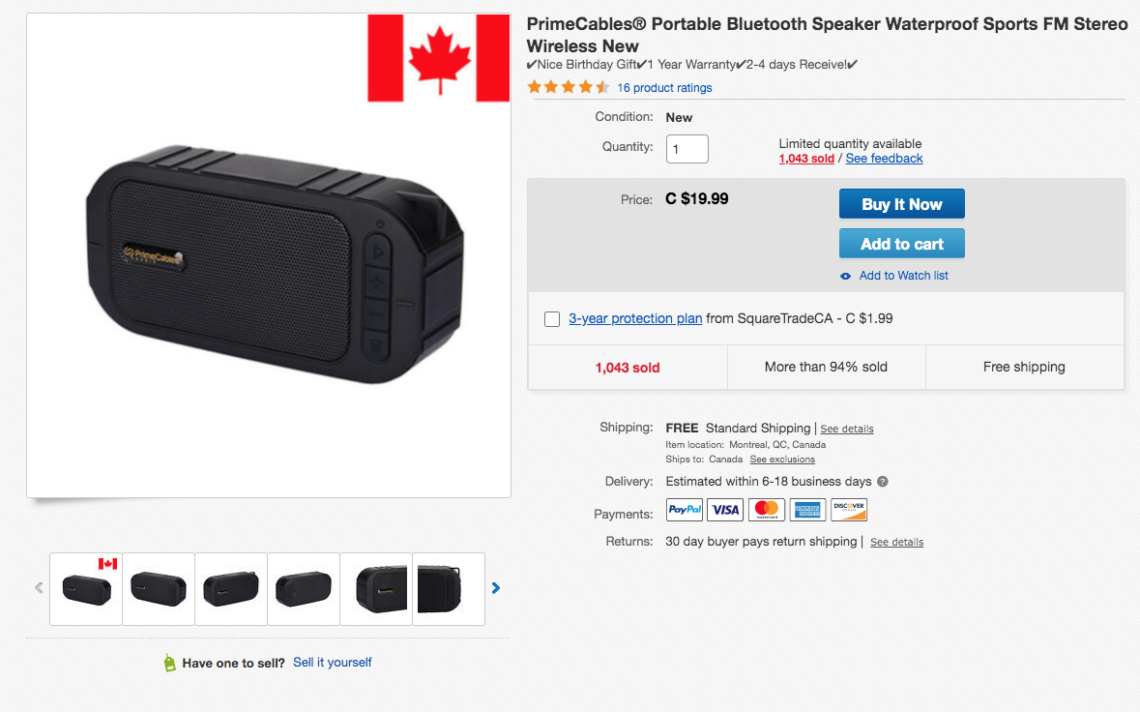
It creates the urgency to buy when a user sees that more than 94% of the product is sold. If you wait to buy, that means you might miss out altogether.
Ebay also invokes the scarcity principle when they feature this deal on their website. A simple tag of “almost gone” intrigues that user to click the product for more information.
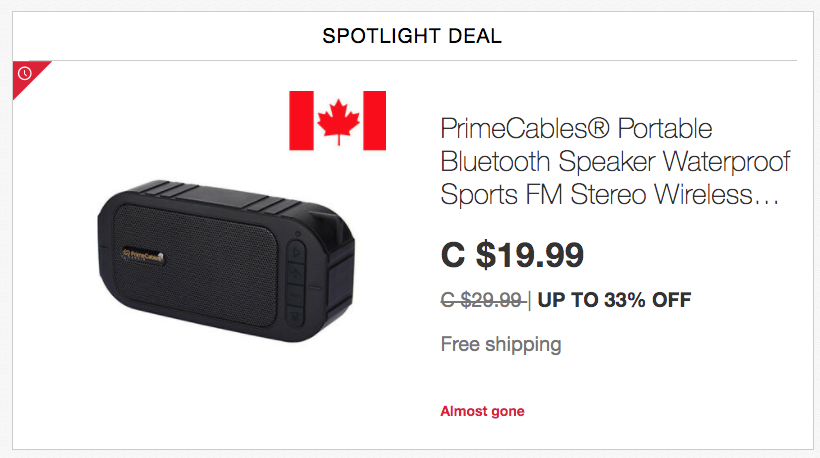
Use scarcity on your site by listing ‘limited edition’ products, keep ‘sold out’ products visible, or feature ‘limited time deals’. If applicable, use sales statistics, such as percentage of products left or number of products sold, to heighten the urgency to buy.
To effectively trigger the scarcity principle, be sure this information is clearly communicated and strategically placed in high visibility areas throughout your website. To draw further attention to this information use bold colours, such as the bright red used by Ebay.
3. Authority: I Trust The Expert
When an individual has authority on a topic — that is, they are perceived as knowledgeable and credible in that area — they are more likely to persuade us.
As Cialdini highlights, the Principle of Authority is based on “the idea that people follow the lead of credible, knowledgeable experts.”
An expert is regarded as someone who has dedicated a significant amount of time to gain understanding and knowledge on a particular topic. For most rational humans, it makes sense to follow an expert’s consultation when looking for direction within that expert’s area of specialty.
Cialdini noted the benefits of establishing your position of authority and making your expert credentials known. For example, Cialdini explained that real estate agents who prompted their receptionists to remind clients of their credentials (e.g. they’ve worked in this field for over 10 years) received 20% more appointments and an 15% increase in signed contracts.
Even though the receptionist works with the real estate agents (and therefore may benefit from positively portraying their colleagues) the effect remains the same. When the clients knew their agent’s accreditations, they were more persuasive.
How To Use Authority In Your Website?
Here’s the part where you don’t need to be humble. Show off your expertise. Tell your website users why they should trust your products and services. Share how and why you’re qualified in your field.
The popular meditation app, Headspace, has fine tuned their online presence to establish the Principle of Authority. Headspace has dedicated an entire section of their website to show off the science and expertise behind their meditation practices.
Headspace’s Science page highlights meaningful statistics with eye-catching graphics. These short blurbs make the information easy to digest and include compelling percentages to support their claims.
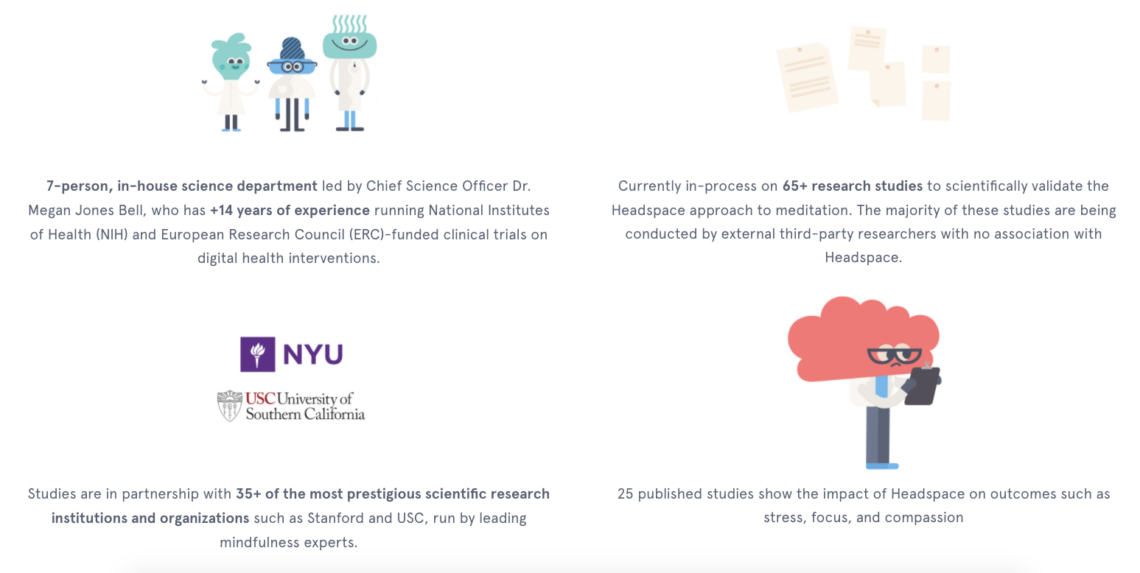
When a user knows that a product or service is being provided by an expert, they may feel greater confidence in the quality of that product/service. For example, I feel more confident that Headspace is scientifically-valid and worthy of my money when I discover that they have a dedicated staff of 7 in-house researchers and third-party researchers developing over 65 current studies, and have 25 published studies related to the science of meditation.
When a user scrolls to the bottom of this page, Headspace also provides a broad resource centre where you can learn more about the science of meditation. By being a rich resource for information about meditation, Headspace is establishing their authority in this area and truly showing users the extent of their knowledge.
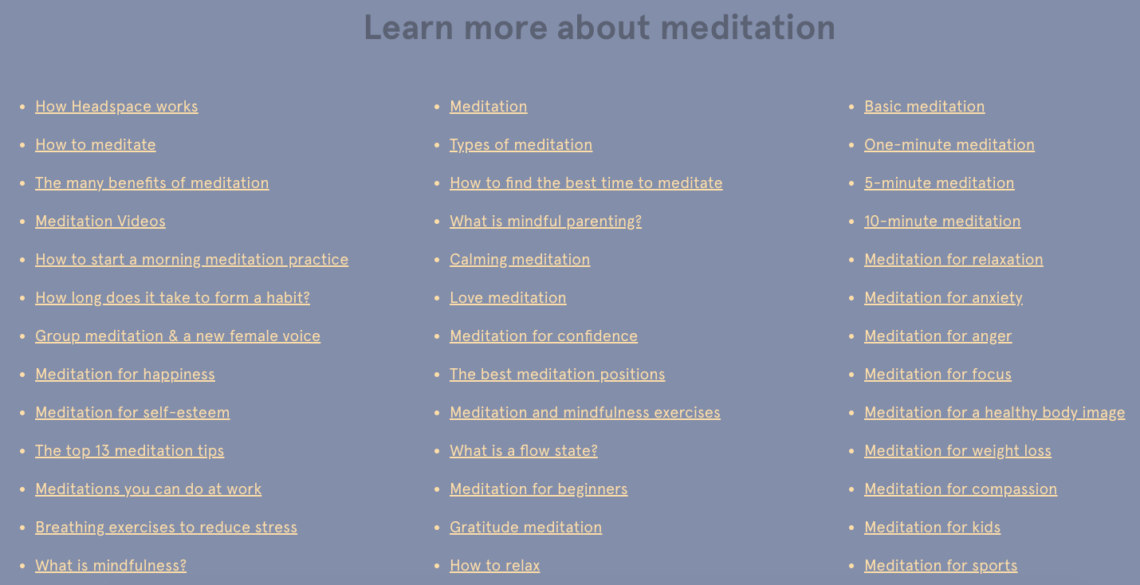
Headspace also establishes authority by sharing the expertise of the company’s founder, Andy Puddicombe. Introducing an “About Us” page into your website is an ideal opportunity to gain authority with your users. Share the story of your humble beginnings, including the qualifications, certifications, and expertise that make your business stand out from your competitors. On Headspace’s About Us page, they feature Andy’s story.
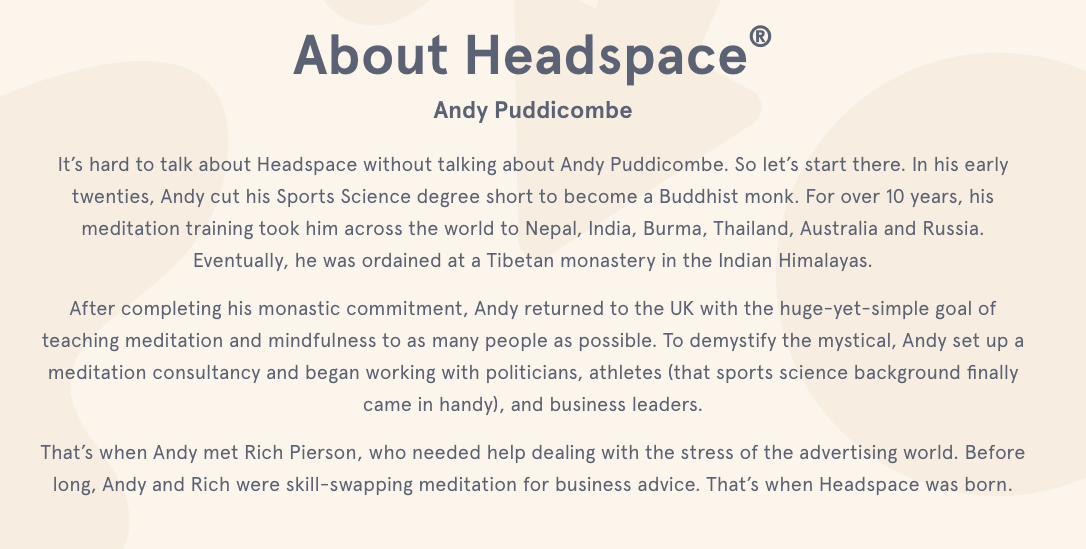
In his story, Andy gains authority in two ways. First, by telling the user his qualifications. He is a Buddhist monk, a title that happens to be highly regarded in meditation. Second, they share how he gained these qualifications. Andy has dedicated 10 years of his life to studying in various countries across the world with other experts in meditation. When we know these facts, we are more persuaded to believe that Andy knows a thing or two about meditation.
Now that Headspace has established Andy’s authority on meditation, they remind users of Andy’s expertise when they’re considering buying a subscription for guided meditation from Headspace.
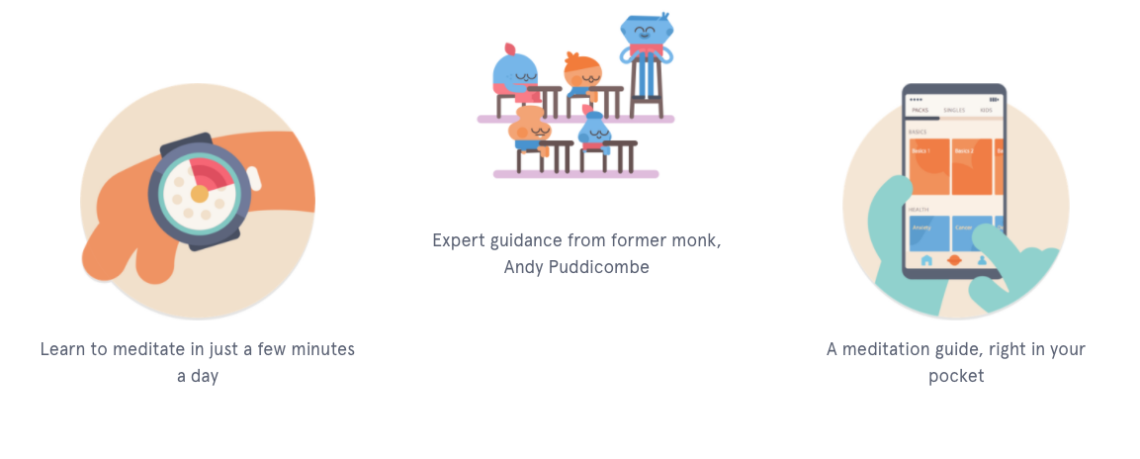
On this subscription page, we only need a brief sentence to trigger the Principle of Authority. In other words, a quick reminder that Buddhist monks have credibility and authority in meditation. This trigger reminds the user: buying a Headspace subscription isn’t just buying a meditation app, it’s guidance from an established meditation expert.
Establish the authority of your expertise. Use your website to share your business’ knowledge, certifications, and innovative practices. Back up your claims with a resource centre, webpage, or blog that shares valuable information about your business’ specialization. Additionally, incorporate an “About Us” page to showcase the qualifications of your team.
Lastly, to persuade website users to convert, ensure your sales page includes small triggers that reference your business’ certification or reference your team’s expertise, such as logos for certification programs completed, a reminder of years’ of service, or experience in your field.
4. Consistency: Can I count on you?
People value consistency. As individuals, we aim to be consistent with our past actions and words.
Cialdini points out how the Principle of Consistency can be persuasive. To do this, start with a small commitment. When someone agrees to a smaller commitment, it makes them more likely to agree to a larger commitment down the road.
Cialdini recommends getting your initial commitment to be “voluntary, active, and public …and ideally …in writing.” By agreeing to their initial commitment, individuals are compelled to agree to a second larger commitment if they want to appear consistent (which most of us do!).
How To Use Consistency In Your Website?
Businesses can use the Principle of Consistency with their consumers by making initial purchases appear as smaller commitments with flexible return policies. Specifically in ecommerce shopping, flexible return policies can act as a ‘vote of confidence’ for the quality and satisfaction of that product.
When products have a flexible return policy, users know that they aren’t fully committing to the purchase. They are simply committing to having the purchase shipped to them, and if they aren’t satisfied, refunded.
In a 2019 survey conducted by MarketCube, 24% of digital shoppers said that they review the return policy prior to purchase and 29% expected this information to be available directly on the product detail page.
As an online shopper, I feel more compelled to buy when I know I can return it. Why not see if I like it? That’s a much smaller commitment in comparison to a non-refundable purchase that I’m stuck with.
For example, Mountain Equipment Co-op (MEC) is well-known for their “Rocksolid Guarantee.” The outdoor company guarantees to deliver on quality. To back up their guarantee, there’s no time limit on returns. If something isn’t up to snuff, then bring it back.
This guarantee also extends to advice given by their employees. For example, if a sales associate recommended a size 6, when you really needed a size 7, that’s enough of a justification to prompt a return of the size 6 product.
Not only does this show MEC’s confidence in their product quality, it also makes the company instantly more likeable (who doesn’t want a laid-back return policy?).
It comes as no surprise that this Rocksolid Guarantee is advertised below the conversion button on every one of their product pages. This trigger gives users an extra confidence boost before they buy. There’s no downside to buying now, if you can return it later.
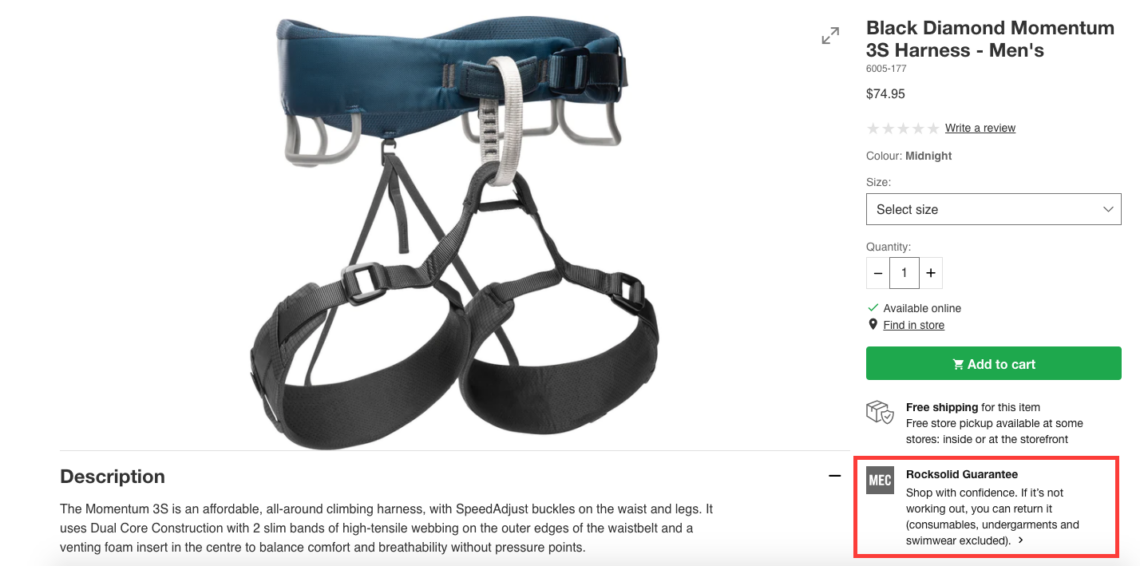
MEC wants to ensure that users know about their return guarantee, so they’ve also advertised it on their homepage.
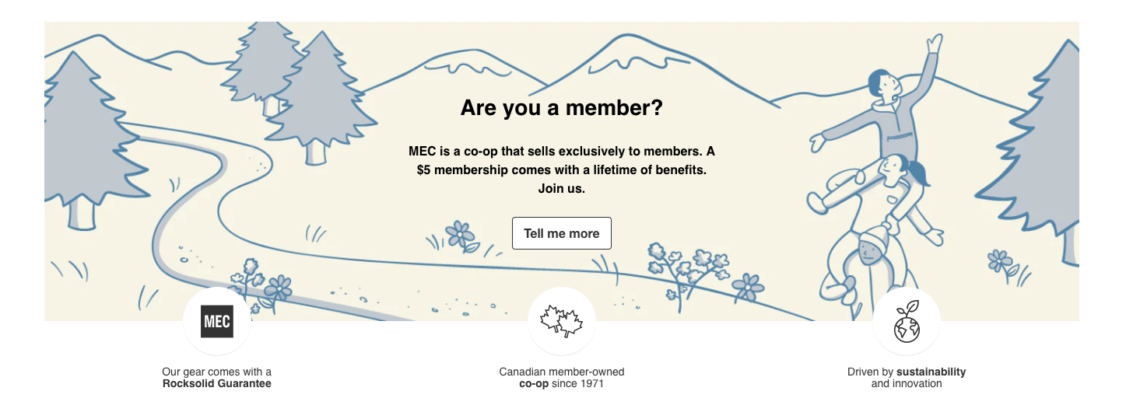
In case any users missed it, they also link their return policy in their website footer. This allows their guarantee to be visible on all pages throughout the site.

Take note of MEC’s sensible approach; consider whether flexible returns or refunds are suited for your business. Especially if you’re in the business of ecommerce, the benefits can outweigh the drawbacks.
Once you’ve established your policy, find creative ways and unique placements to be certain that every website user knows about it. Need help to find the most effective approach? You can consult with our web design experts at Navigator.
5. Liking: It Pays To Be Likeable
According to Dr. Robert Cialdini’s Principles of Persuasion, we are agreeable with people we like. Cialdini breaks down the Principle of Liking into three aspects:
“We like people who are similar to us, we like people who pay us compliments, and we like people who cooperate with us towards mutual goals.”
Being well-liked is good for business. Cialdini notes several experiments that have shown that people who used aspects of liking were 90% successful in negotiating agreed business terms compared to 55% of those who did not.
Fortunately, the Principle of Liking isn’t restricted to just individuals; businesses can also use this principle to appeal to their consumers.
Focus on two strategies to build likability with your consumers:
1. Share Your Brand Values.
We like people who are similar to us. Businesses can become more likeable by showing their similarities with their consumers.
To do this, businesses must know their audience. Let me repeat that for extra emphasis. Businesses must know their audience.
By knowing its customers, a company can showcase its similarities. When a brand has values that align with our own, we’re more likely to like that brand.
2. Show How You’re Supporting Your Brand Values.
We like people who cooperate with us towards mutual goals. If a business has shared values with their consumer, this can be viewed as a common goal between the brand and the consumer. Further, when a business has initiatives that support this common goal, it can feel like cooperation. If I support this brand, then I am also supporting our common goal.
For example, if I’m against animal cruelty and I buy a make-up brand that’s against animal testing, then we share the common goal of animal wellness. Even better, if that make-up brand donates a portion of their sales to stop animal testing, then we are working together to fight animal cruelty. If I support this make-up brand, then I am also supporting the cause for animal wellness. Knowing this makes me like that make-up brand more.
What initiatives is your company doing to show their commitment to their brand values? If a consumer supports your company, will they feel like they’re supporting a common goal?
How to Use The Principle of Liking On Your Website?
Although you can’t smile and welcome users to your website, you can still tap into the liking principle. When incorporating these aspects into your website, clear communication and visible placement are key. Users need to see and understand your initiatives to feel compelled by them.
For example, direct-to-consumer shoe company Allbirds is upfront about its commitment to sustainability. While many companies claim to be eco-friendly, not all business practices live up to environmental claims. Allbirds stands by its eco-commitment by being transparent about the carbon emissions produced during product manufacturing. On their homepage, Allbirds highlights their carbon stats with a moving graphic to catch the users attention.
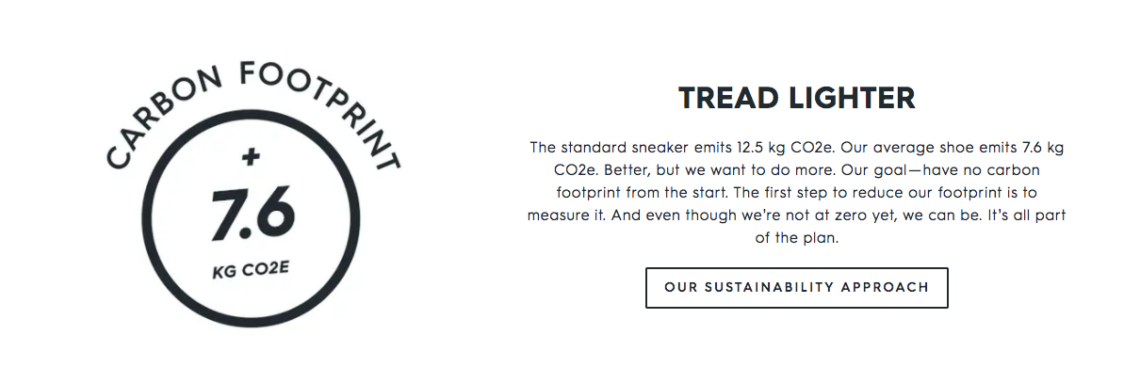
Additionally, this section also links to a dedicated sustainability section on their site. This section provides a more detailed outline of what they’re currently doing and what they’d like to achieve with their sustainability.
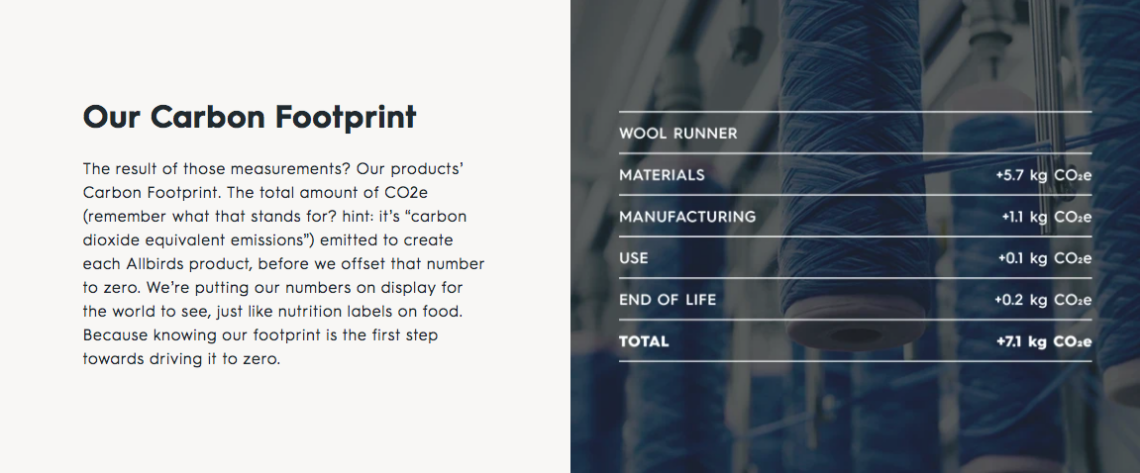
Not only does Allbirds dedicate a page to sustainability, but it also lists the carbon emissions statistics for each product on the website. This strategy reminds online buyers about the Allbirds sustainability commitment before they buy.
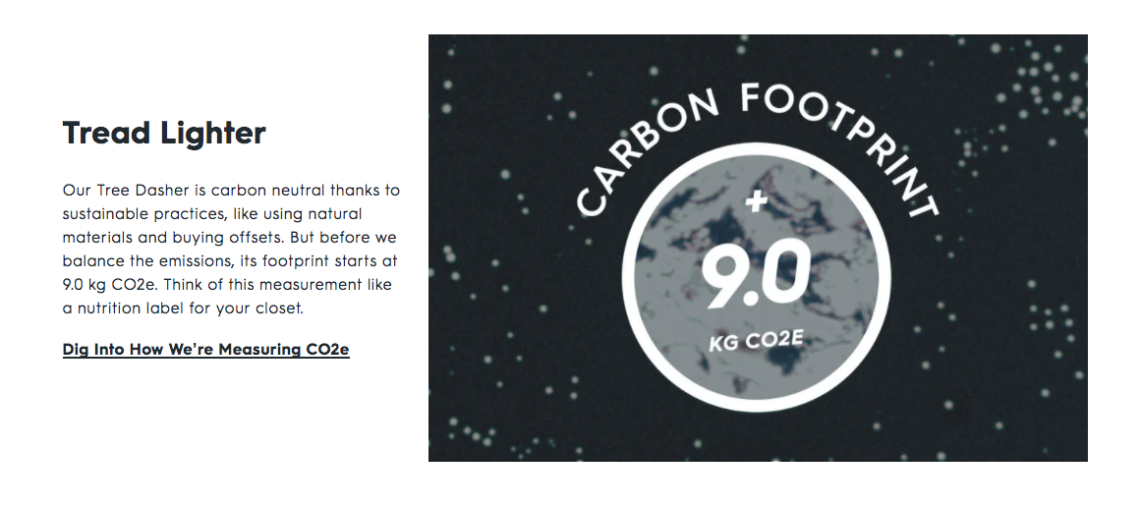
This transparency within the sustainability commitment shows consumers that:
- Allbirds has an eco-friendly mindset which is likely shared with its consumers.
- As an organization, Allbirds is working toward this common goal of sustainability through its actions.
By standing by core values and sharing them with customers, Allbirds is building loyalty and trust with online shoppers. Build camaraderie with your customers by showing them what you stand for. Communicate your business’s core values and initiatives that support these values.
6. Consensus: I’ll Have What She’s Having
When making a decision, it is common to look to the actions of others to aid in our decision-making process. Comparing other people’s behaviours and outcomes affects how we choose to proceed.
When describing the Principle of Consensus, Dr. Cialdini explains that “Especially when they are uncertain, people will look to the actions and behaviors of others to determine their own.”
This means that being aware of other people’s behaviour in turn affects our own decisions and actions. If I’m considering watching that new sci-fi series on Netflix, but my friend tells me she fell asleep during the first episode, then I may reevaluate my decision to grab the remote.
The Principle of Consensus also applies to our digital behaviour. In fact, having confidence in our online purchases is even more vital compared to shopping in a traditional brick and mortar store. Online shoppers aren’t able to hold a product and physically inspect the quality, so they must rely on other means of building trust.
Online reviews allow users to build trust and confidence that they are choosing the right product. If I want to buy a new pancake maker and I see that 94% of other online shoppers left a 5-star review for that product, then I’ll feel more confident to make the purchase.
How to Use The Principle of Consensus On Your Website?
Fortunately, there are several approaches to incorporating the Principle of Consensus into your business’ website. To build consensus on your website, you can:
- Share Customer Testimonials.
- Allow Online Reviews.
The bottom line: give users the chance to learn about the behaviours and outcomes of other customers. Show that other people have engaged with your business and had a positive outcome. This can make new users feel more persuaded to become a customer themselves.
Don’t think that customer testimony or online reviews affect your business? Consider Tripadvisor.
Tripadvisor has become the go-to resource for travellers looking to create a memorable experience in a new city. In a 2019 News Release, Tripadvisor helped almost 460 million travelers per month. That’s right, 460 million per month, not year, month. Additionally, over 830 million reviews have been left on the platform for various travel-related experiences.
Why is the platform so effective? Because it is driven by the reviews and experiences of others who can help inform our own decisions – even if they are complete strangers on the internet. There is power in consensus, especially in large numbers.
For example, let’s take a peek at the reviews for the Colosseum in Rome.

The Colosseum has received 4.5 out of 5 stars with 146,075 reviews. When we investigate further into these reviews, you’ll also see that the majority of the reviews for the historic site are ‘Excellent’ (105,630) or ‘Very Good’ (31,077).
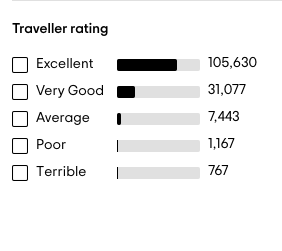
That means that 93% of visitors were quite happy that they stopped by to see the home of gladiators. If I’m on vacation in Rome and I’m questioning whether to make time for the Colosseum, knowing these numbers makes my decision a little easier.
Use consensus to your advantage. Give your customers a voice and show off their responses. Implement reviews, show review percentages and award ‘certificates of excellence’ for products or services that perform well. Implement these features into various relevant areas on your website. The aim is to communicate a clear message to your website users. There is an agreed consensus that past consumers were happy about purchasing your products or services.
To build a persuasive website, implement the psychological Principles of Reciprocity, Scarcity, Authority, Consistency, Liking, and Consensus. These tactics can subtly and ethically persuade your website users to become consumers.
At Navigator, we’ve got website design wizards to help you build a website that will drive more sales. Contact us for a free consultation.



9
Brenda
Very thorough and well laid out. Some great information - easy to capitalize on and incorporate into a website.